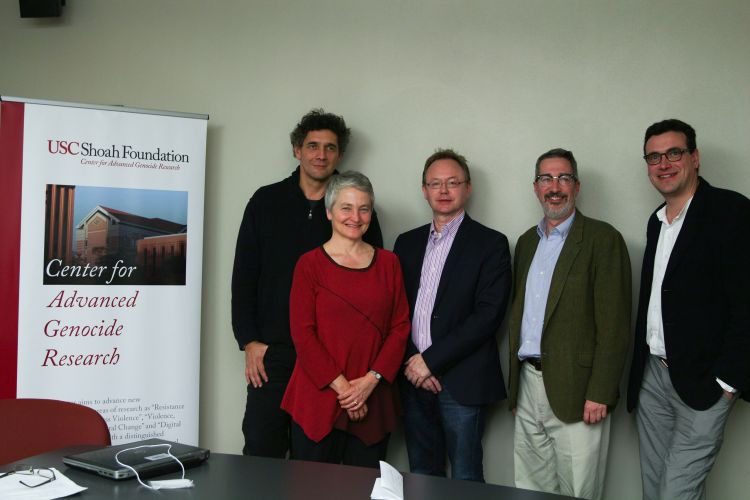Mapping the Holocaust through Testimony
The multidisciplinary Holocaust Geographies Collaborative research group returned to USC Shoah Foundation and shared their plans for an exciting new project harnessing the power of testimony that will begin this summer. Tim Cole (Bristol University), Alberto Giordano (Texas State University), Paul Jaskot (DePaul University), and Anne Knowles (University of Maine) reflect on their weeklong research visit at USC Shoah Foundation’s Center for Advanced Genocide Research, which concluded with a public talk on January 12, 2016.
Our collaborative process as the Holocaust Geographies Collaborative has always been most creative and penetrating when we are physically in the same place. Having five days working together at USC Shoah Foundation’s Center for Advanced Genocide Research, talking over meals -- talking all the time, actually -- enabled us to challenge one another and make great strides in conceptualizing our ideas for how to identify, extract, analyze, and represent the spaces and places that survivors experienced in the Holocaust.
 Our group with Director of USC Shoah Foundation Center for Advanced Genocide Research Wolf Grunner.
Our group with Director of USC Shoah Foundation Center for Advanced Genocide Research Wolf Grunner. Having complete and full access to the Visual History Archive materials on site enabled us to move effortlessly from survivor video testimony to our databases and other research materials. This was particularly important for those of us who do not have access to the full Visual History Archive at our own institutions.
It was invaluable to be able to consult with staff members who know the Archive inside and out, from its IT architecture to the logic of the index, from how place names were geocoded to the latest ideas about what can be added to newly indexed collections to capture, for example, the emotional content of testimony. Learning from USC Shoah Foundation’s Chief Technology Officer Sam Gustman about the newly announced Visual History Archive Program now underway was thrilling, because many of the visionary goals coincide closely with our group's research agenda. We were also deeply impressed by the New Dimensions in Testimony project, 3D interactive testimony, and were grateful to see it demonstrated. It's thrilling to be part of such a forward-thinking, venturesome intellectual enterprise.
The opportunity to give a presentation on our research pushed us to make the most of our time together. It was wonderful to be able to share our thoughts at this early stage with smart graduate students and experienced scholars from USC and UCLA.
In short, our five-day work session at USC Shoah Foundation’s Center for Advanced Genocide Research catapulted our project forward, prepared us for our next step (which will be to learn corpus linguistics methods to apply to testimony in the Archive), and deepened our knowledge of the testimonies preserved in the Visual History Archive and their digital infrastructure. The last point will be crucial for our future major grant applications.
Lastly, we greatly appreciate the generosity and openness of the excellent staff who gave us their time and so patiently answered our questions. Their interest in our project and their exceptional support made the Visual History Archive and the Center for Advanced Genocide Research seem very much research partners with the Holocaust Geographies Collaborative. We cannot thank the team at USC Shoah Foundation enough.